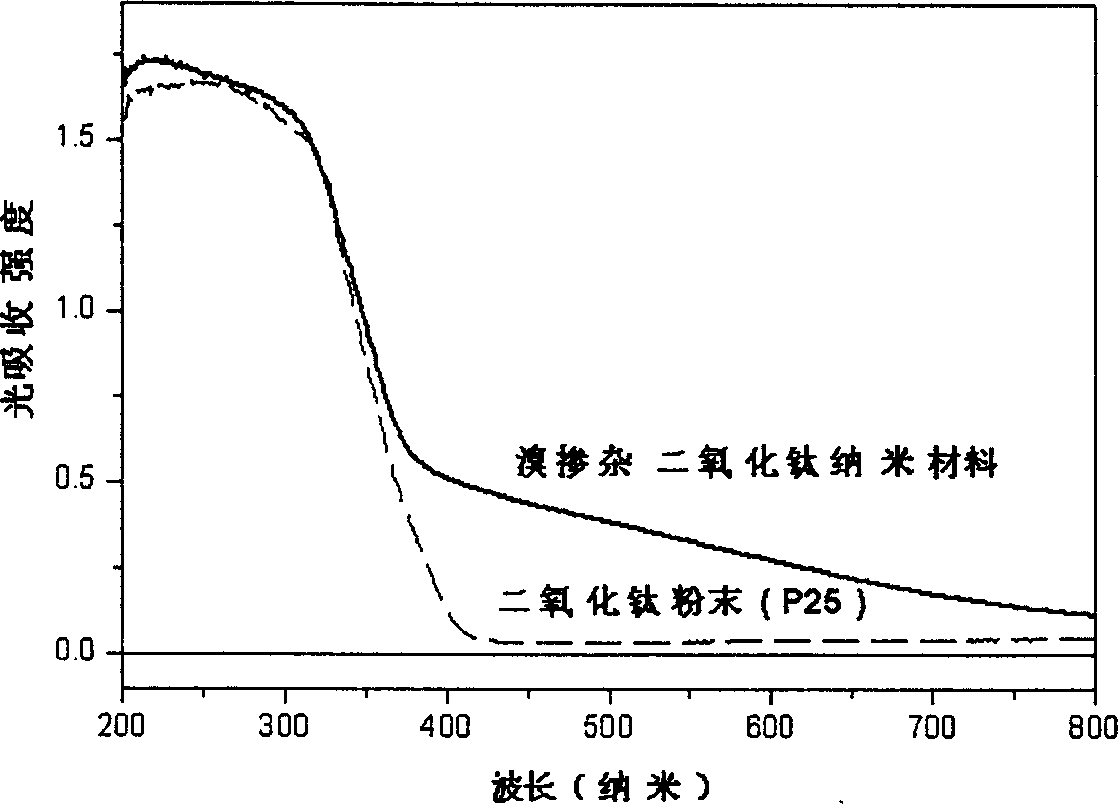Preparation method of photocatulyzed active bromine adulerated titanium dioxide nano-material
A photocatalytic activity, titanium dioxide technology, applied in titanium dioxide, chemical instruments and methods, titanium oxide/hydroxide, etc., to achieve the effect of simple preparation method and high light quantum efficiency
- Summary
- Abstract
- Description
- Claims
- Application Information
AI Technical Summary
Problems solved by technology
Method used
Image
Examples
Embodiment 1
[0026] 15ml of bromine aqueous solution (3% by mass) was reacted with 10ml of tetrabutyl titanate (>98.0% by mass) until a white precipitate was completely formed. The white precipitate was directly heated in an oven, treated at 120°C for 8 hours, evaporated to remove water and alcohols produced in the reaction to obtain a solid dry product. Then grind the obtained dry solid to make the particles uniform and reduce soft agglomeration. Put it into a muffle furnace after grinding, and calcinate at 320° C. for 2 hours to obtain a bromine-doped titanium dioxide nano-catalyst material with high catalytic activity under visible light. In the catalytic activity test, the first-order reaction kinetics apparent rate constant k=6.86×10 of the catalyst material catalyzes the degradation of phenol -3 min -1, is titanium dioxide powder (P25, Degussa) first-order reaction kinetics apparent rate constant k=1.04×10 -3 min -1 It can be seen that after heat treatment for 2 hours, bromine-do...
Embodiment 2
[0029] 15ml of bromine aqueous solution (3% by mass) was reacted with 10ml of titanium sulfate (>40.0% by mass) until a white precipitate was completely formed. Rinse the resulting white precipitate with deionized water until the anion (sulfate ion) concentration is less than 0.5 mg / L. It was then filtered to collect the precipitated material washed with deionized water. The white precipitate was directly heated in an oven, treated at 120°C for 8 hours, evaporated to remove water and alcohols produced in the reaction to obtain a solid dry product. Then grind the dry solid to make the particles uniform and reduce soft agglomeration. Then it is placed in a muffle furnace and calcined at 350° C. for 2 hours to obtain a bromine-doped titanium dioxide nanometer material with high catalytic activity under visible light. In the catalytic activity test, the first-order reaction kinetics apparent rate constant k=5.41×10 of the catalyst material catalyzes the degradation of phenol -3...
Embodiment 3
[0031] 10 ml of hydrogen bromide solution (2 mol / L) was reacted with 10 ml of tetrabutyl titanate (mass percentage>98.0%) until a white precipitate was completely formed. The white precipitate was directly heated in an oven, treated at 120°C for 8 hours, evaporated to remove water and alcohols produced in the reaction to obtain a solid dry product. Then grind the obtained dry solid to make the particles uniform and reduce soft agglomeration. Put it into a muffle furnace after grinding, and calcinate at 350° C. for 2 hours to obtain bromine-doped titanium dioxide nanomaterials with high catalytic activity under visible light. In the catalytic activity test, the first-order reaction kinetics apparent rate constant k=5.72×10 of the catalyst material catalyzes the degradation of phenol -3 min -1 , is titanium dioxide powder (P25, Degussa) first-order reaction kinetics apparent rate constant k=1.04×10 -3 min -1 5.5 times. It can be seen that after heat treatment for 2 hours, b...
PUM
 Login to View More
Login to View More Abstract
Description
Claims
Application Information
 Login to View More
Login to View More - R&D
- Intellectual Property
- Life Sciences
- Materials
- Tech Scout
- Unparalleled Data Quality
- Higher Quality Content
- 60% Fewer Hallucinations
Browse by: Latest US Patents, China's latest patents, Technical Efficacy Thesaurus, Application Domain, Technology Topic, Popular Technical Reports.
© 2025 PatSnap. All rights reserved.Legal|Privacy policy|Modern Slavery Act Transparency Statement|Sitemap|About US| Contact US: help@patsnap.com

